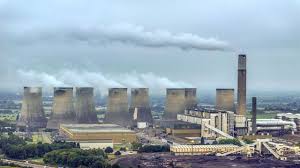The UK coal-fired power station that became a giant battery

London: With the closure of the last coal-fired power station in the UK, it raises questions about how old fossil fuel infrastructure can be repurposed. One option is to use them to store energy from renewables.
It’s an unassuming place for a major era of British history to come to an end. Surrounded by farmland drenched by recent rains and trees with leaves starting to turn ahead of the autumn – all within earshot of the thundering traffic from the M1 motorway – the UK’s last coal-fired power station is shutting down for good. As of 30 September 2024 the turbines at the Ratcliffe-on-Soar power plant in Nottinghamshire will fall silent while smoke and steam will cease to belch from the chimney and cooling towers that dominate this part of the landscape.
The power station, which has been operating since 1967, is to undergo a two-year decommissioning and demolition process.
It’s a symbolic moment, a marker along the UK’s journey to decarbonisation and net-zero. For centuries, coal was the main source of energy in the UK. It was the life-blood of the industrial revolution – providing the fuel for steam engines and then generating much of the country’s electricity. By the 1960s, nearly 90% of the UK’s electricity relied upon coal.
Now, for the first time, the UK will not use any coal to generate electricity.
It’s not clear what the Ratcliffe-on-Soar site will become. There have been suggestions it could house a prototype fusion reactor or some other green industry. Regardless, as fossil fuel power plants are shuttered in many parts of the world, the question of what to do with them will keep coming up.
One promising option is to turn old fossil power plants into battery storage sites.
Renewable energy sources like wind and solar are the mainstay of the net-zero transition. They don’t emit greenhouse gases, so the more they replace fossil fuels like coal and gas the closer we come to net-zero emissions.
The share of energy coming from renewables is rising steadily. According to a report by the International Energy Agency published in January 2024, renewables will generate 33.5% of global electricity this year and could account for 41.6% by 2028.
However, using renewables comes with challenges for power grids. Coal and gas plants can be turned on and off at will, so they can supply more energy when it is needed: they are “dispatchable”, in the jargon of the field. By contrast, renewable sources are intermittent and less controllable: the Sun doesn’t shine at night and the wind doesn’t always blow (and sometimes can blow too much).
“With renewables, we have less dispatchable power,” says Grazia Todeschini, an electrical engineer at King’s College London in the UK.
To some extent, the intermittency problem can be managed by having a diverse selection of renewable sources: that way, if one doesn’t generate enough, another can pick up the slack. Nuclear power, which is zero-carbon, also offers a steady supply.
Alongside this, though, countries are investing heavily in energy storage. When lots of electricity is generated but isn’t needed, it can be stored – then when there is a shortage it can be released. “The main point is to be able to match generation and demand,” says Todeschini.
Getty Images One of the UK’s defunct coal plants in Ferrybridge, West Yorkshire, is being turned into a battery energy storage system (Credit: Getty Images)Getty Images
One of the UK’s defunct coal plants in Ferrybridge, West Yorkshire, is being turned into a battery energy storage system (Credit: Getty Images)
For many decades, the most important form of energy storage was pumped hydropower. Excess electricity was used to pump water uphill, so that it could be released to drive turbines and generate electricity when needed. However, this won’t be enough for the renewable era, and hydropower has its own emission problems too. “That capacity pretty much is saturated everywhere, in Europe at least,” says Todeschini. “There is no space to build any more.”
That’s why many countries are turning instead to battery energy storage systems (BESS). A BESS site is simply an array of batteries: big ones, about the size of shipping containers. Excess electricity from renewable sources can be dumped into the batteries, ready to be discharged when demand is high.
“In the last 20 years, this technology has improved a lot,” says Todeschini. “The control is more precise, and also the cost has decreased.”
All of which explains why one of the UK’s defunct coal plants is being turned into a BESS site.
Near Ferrybridge in West Yorkshire sit the remains of a trio of coal-fired power plants. Between them they operated for almost a century, the first one turning on in 1927 and the last being decommissioned in 2016. The third station, Ferrybridge C, passed into the ownership of energy company SSE in 2004, which ran it until the site’s closure and demolition.
Now SSE is building a BESS on the site of Ferrybridge C. It will have a capacity of 150 megawatts, which SSE estimates will be enough to power 250,000 homes. Construction began in August 2023, and in June 2024 the first batteries arrived. The following month, the last of the 136 battery units were installed.
“We’re now at the point all the kit’s on site,” says Heather Donald of SSE Renewables, where she is director of onshore wind, solar and battery for Great Britain and Ireland. “We’re just about to go into the commissioning phase and we’re hoping to switch on early next year.”
Building an array of batteries on the site of an old coal-fired power station has multiple advantages, says Donald. “First and foremost, there’s a grid connection there,” she says. That means linking the BESS to the grid is as straightforward as it can be. “Access to grid connections and grid capacity’s at such a premium now.”
In the Lusatia region of Germany, there is an intricate system of coal mines and thermal power plants operated by the energy company LEAG. In 2023, the company – which specialises in the dirtiest form of coal, lignite – announced a plan to transform the entire complex into a “green energy hub”. This will include wind and solar, hydrogen and batteries, and is intended to be completed by 2040. An early step will be to convert the Boxberg coal plant into a BESS facility, to be operational by 2027. In June 2024, LEAG secured €58 million of European Union funding to support the project.
On the other side of the world, the former Liddell Power Station in New South Wales, Australia, is becoming the Liddell Battery. The site’s owner AGL Energy announced the project in December 2023 and construction began in June 2024. The 500-megawatt batteries should come online in December 2025.
Finally, Nevada is home to a project that is already storing and supplying electricity. The coal-fired Reid Gardner Power Station, 50 miles (80km) north-east of Las Vegas, was demolished in 2020. A company called Energy Vault has since replaced it with the Reid Gardner Battery Energy Storage System, which has a capacity of 220 megawatts. The site came online in late April 2024.
The more projects like these come online, the better they will become, argues Donald. “It’s obviously an emerging technology,” she says. Donald expects BESS to become more efficient and to be able to discharge electricity for longer periods – helping ensure a secure electricity supply after all the fossil fuel plants have been turned off for good.





